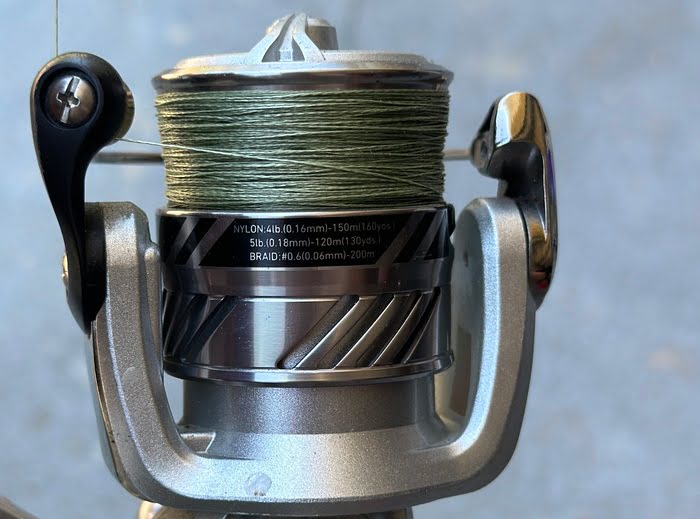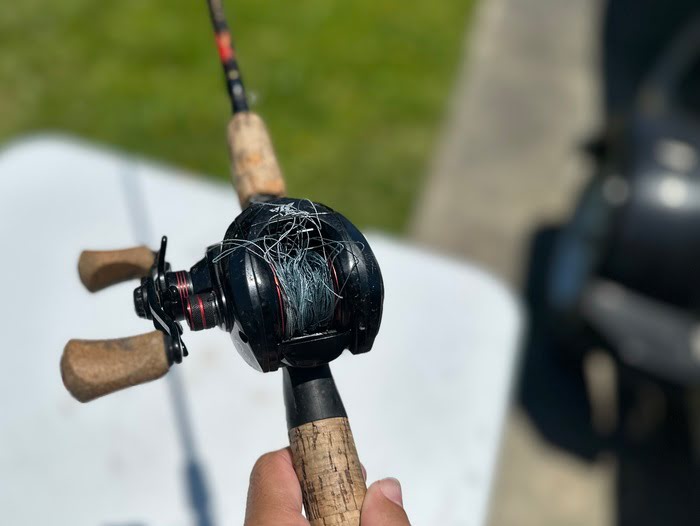We’ve all been there: one minute you’re having a blast out on the water, and the next your fishing line is twisted up into an unusable bird’s nest.
At best you have a few minutes of work ahead of you, and at worst you’ve just lost a whole bunch of lines (and maybe whatever you had tied on!).
In this article, I’m going to cover the 3 most common reasons your fishing line keeps getting tangled and how you can prevent it from happening.
Table of Contents
Incorrect Line Spooling
The spool is the metal drum inside your reel that holds the fishing line. It can be described as the heart of every cast you’ve ever reeled in; it’s where your line comes from, and after you catch that monster fish, it’s where the line returns to!
Understanding the spool, and the way that fishing line interacts with it, is crucial to prevent some of the most common tangles you can experience!
To start, the most common cause of tangled lines is overspooling. In short, a fishing reel is only meant to hold a certain amount of fishing line within it, and putting in more than that can lead to issues when casting.
Have you ever flipped open your bail to cast, only for several loops of line to jump out and make a mess of itself getting wrapped around the reel? That’s what happens when you over-spool!

Knowing when to stop spooling is an important first step to cutting back on line tangles. Many reels have a line or mark in the spool that shows how far up the line should rise when it’s “full.”
If there isn’t one, a good rule of thumb is to keep between an eighth and a quarter inch of space between the line and the edge of the spool.
It’s also important to make sure the line spools evenly when it goes on. The loose line can kink up when being reeled in, and these kinks can cause some gnarly backlash during casting!
When spooling up a reel, I keep it attached to the pole and nestle the back end into my arm as a brace. I extend my pointer finger forward away from the reel and curl it slightly inwards, forcing the line to bend over my finger before it reaches the reel.
This works wonders to keep tension on the line when spooling, preventing kinks and ensuring that the line lays down nicely.
Next, make sure the line you’re using isn’t too big for your reel. The bearings and line guides in an ultralight spinning reel are much smaller than those in a deep sea saltwater reel, and the ultralight will have a whole lot of trouble effectively controlling 40-pound test line.
Running a line that’s too big for your spool size can increase the chances of line jumping just like over spooling, and can pinch the line, reducing its lifespan.

Most reels will let you know what line diameters they’re designed for on the packaging, and fishing line packaging will likewise tell you what diameter they are. Make sure they match up!
There are many other reasons to choose heavier or lighter lines within this range depending on your target species and angling style, but above all else, the most basic rule is to make sure your spool is designed for the line you’re using.
See Also: High Vis vs Low Vis Fishing Line: Pros & Cons
Fishing Line Memory
The spool also plays a separate role in tangling: line memory!
This phenomenon comes from the latent elasticity in the monofilament and fluorocarbon fishing line; that is to say, it ‘remembers’ its shape if it’s been held there for a long time. It will want to hold that shape unless there are forces preventing it from doing so.
So, when you take the line off of the spool you bought it on and wind it onto the differently-sized spool in your reel, there’s a disconnect between the ‘remembered’ line shape and the new one.
This can cause the line to behave weirdly when casting and can increase the likelihood of the line getting wrapped around itself (and hopelessly tangled) during the process.
An easy fix is to let a newly spooled reel sit for a while before using it. A few days is ideal, but even an overnight sitting can greatly reduce the stress the fishing line is under.

The longer your line is in its new spool, the more its ‘memory’ adapts to that shape!
Soaking your fishing line in warm water can help speed up this process even further by relaxing it. A 20-minute soak will do wonders, and you can soak the line lose or dunk in your newly spun spool (just be sure to dry it thoroughly in the latter case)!
If you’re willing to spend a little bit extra, the braided line has far less memory than monofilament and will re-spool without any hassle.
The braided line of a given weight test is also much smaller than the equivalent test mono line, meaning you can pack much more of it onto a spool without sacrificing strength!
See Also: What Is The Best Fishing Line For Bluegill?
Poor Technique
Even if your rod and reel are set up perfectly, some poor practices can cause tangles regardless. You may find that changing your technique can cause a marked decrease in tangle incidents without any changes to your gear!
On some occasions, line will continue to unspool during a cast, even after the bait or lure has hit the water. This results in a lot of slack in the line.
Reeling in loose line can cause it to bunch up when passing through the bail, causing tangles. Keeping a little bit of tension on the line at all times can help prevent this!
Thankfully, the pointer finger technique that I explained for spooling up a reel can work just as well for post-cast slack removal.
Simply keep that finger extended until you’ve reeled in all that slack, then continue to retrieve your bait as normal (or let it sit depending on how you’re fishing!).
This trick has the added benefit of increasing your bite sensitivity. Too much slack in the line may prevent you from feeling some smaller hits, reducing your hookup rate. So tension is your friend when fishing for multiple reasons!
Lure Weight
The other factor that can lead to an increase in tangled lines, especially when casting is incorrect lure weight.
Casting a lure that is too heavy, or too light, can cause your reel to unspool incorrectly, which often leads to bird nests and backlashes.

That is why it is so important to choose a rod, reel, and fishing line that is rated for the type of fishing you plan on doing.
Almost all rods will have a lure weight range stamped just above the grip. This is the recommended lure weight for that rod (and the appropriate reel).
If you cast a lure that is too heavy, it can cause your spool to spin way too fast, creating a backlash.
And if you cast a lure too light, your lure may not be heavy enough to properly peel off the line, causing your spool to spin but the line to just loosely bunch up.
What About Baitcasting Reels
Baitcasting reels are notorious for getting tangled and creating the dreaded ‘backlashes’, especially for beginners.

The most important thing to keep in mind with baitcasting reels is that they have a magnetic brake and a tension knob. Both of these setting adjustments dictate how your reel performs, and if not tuned properly, will lead to backlashes and bird nests.
If you’re having a lot of problems with your baitcasting reel backlashing when you cast, chances are it’s just not tuned properly for the weight/lure you are using.
This video does a great job of breaking the process down:
These reels have a much steeper learning curve than a traditional spinning reel or push-button reel, but with a little practice and tuning anyone can learn to fish with them
You May Also Like: Choosing The Best Fluorocarbon Line For Baitcasters
Conclusion
Tangles are a nightmare to sort out, and doing so a few times is considered a rite of passage for any beginning angler.
You’ll never be rid of them entirely (even the pros get tangled lines!), but adopting these techniques can knock tangles down from a constant annoyance to a once-in-a-blue-moon event.
Thanks for reading and good luck!
If you haven’t guessed yet, I love fishing and everything about it!
To learn more about why I started Panfish Nation, visit the About page and follow along on Social Media:


Download a copy of my FREE Lure Color Selection Chart & Knot Guide!
Stay up to date with fishing reports, tackle reviews, industry news, and much more! We respect your privacy, unsubscribe at any time.
